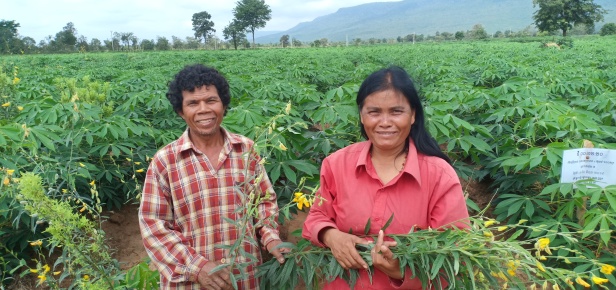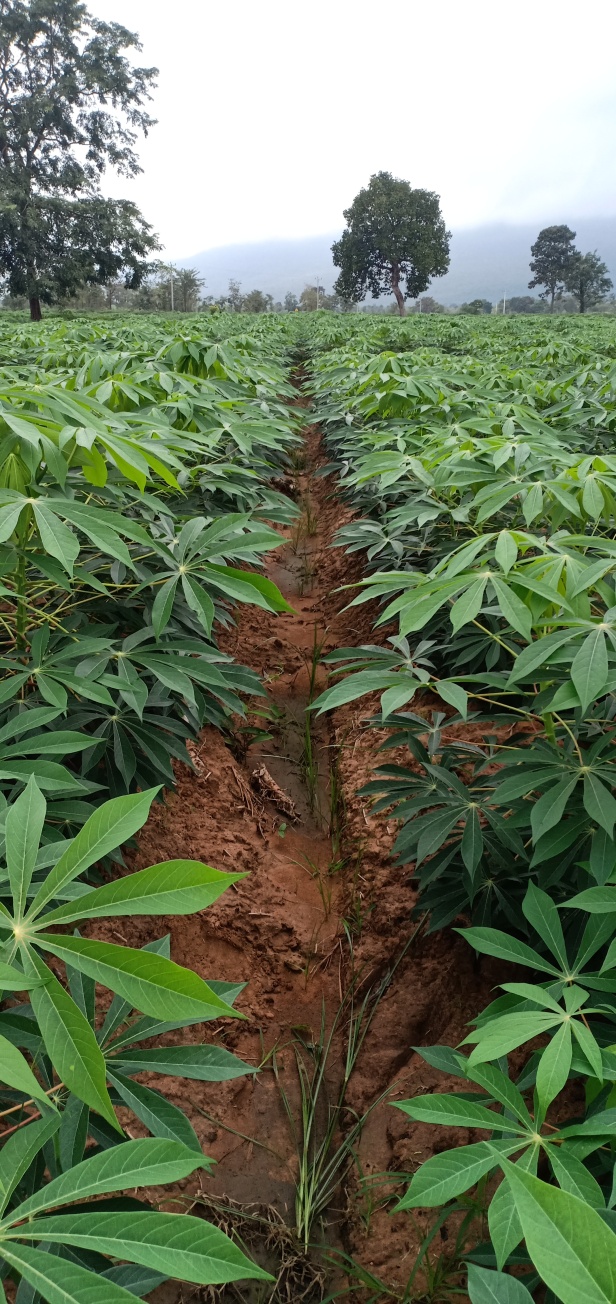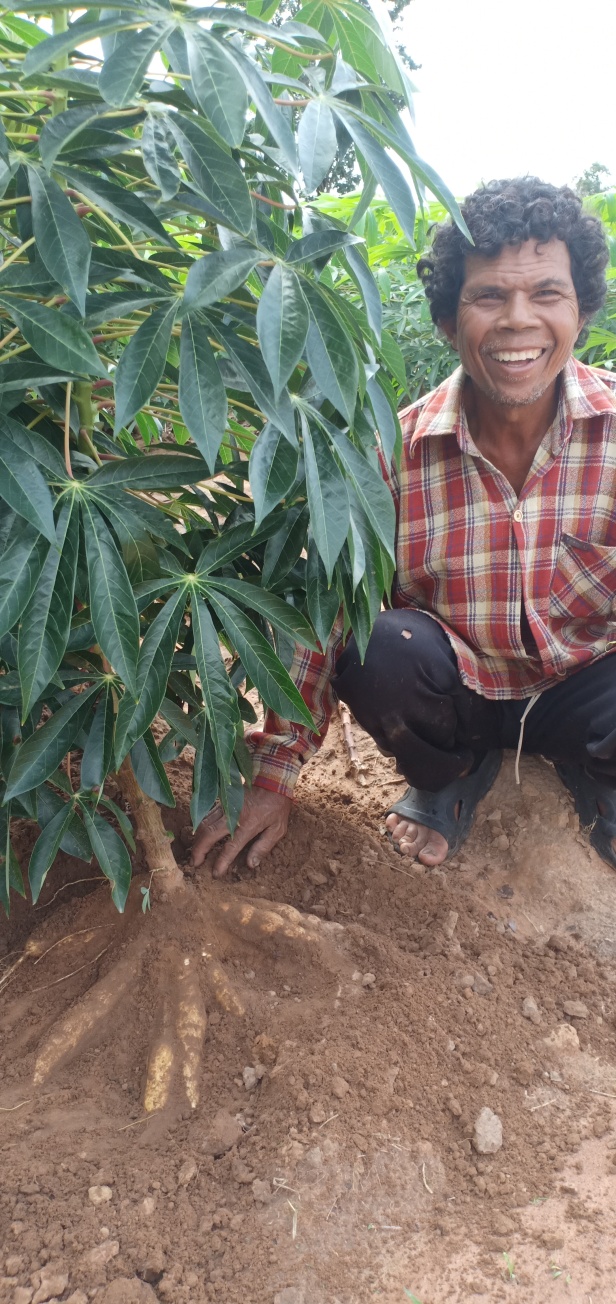Banteay Meanchey province: Cassava planting is an important agricultural activity in Cambodia. For example, the farmers in Tboung Khmum, Preah Vihear, Kampong Thom, Pailin, Ratanakiri, Mondul Kiri, Banteay Meanchey, etc. Farmers produce cassava for the commercial purpose, farmers sell fresh or dried cassava to buyers, mostly exported to neighboring countries (Vietnam and Thailand). Even the cassava production has increased, but sometimes farmers encountered problems, especially pests and disease, resulting in low yield and starch. The selection of good planting materials is an important problem observed among cassava farmers. Sometimes, cassava planting materials (cutting stems) from neighboring countries are imported illegally to Cambodia without quality control. Some planting materials are already sick, infected with diseases. If farmers select those kinds of poor quality materials for planting, then the result of the production is not good.
A farmer, named Moun Am, 50 years old, lives in Thlork village, Banteay Chhma commiune, Thma Pouk distrrict of Banteay Meanchey province has attended the training on sustainable cassava production trained by trainers from the International Institute of Rural Reconstruction (IIRR) under the funding support from GIZ. she is different from other farmers who provide cassava starch for selling, but she produces planting materials for selling. This is another opportunity for farmers, while other farmers produced only cassava starch and they don’t have good planting materials for their production.

Ms. Moun Am has a total 3 members, including one daughter in her family. Her daughter is studying at grade 11 and sometimes help in doing the farming activities during the weekend or during the vocation such as fertilizer application, wedding, planting. Ms. Moun Am main occupation solely relies on cassava planting. She has 5 ha of land for planting cassava.
After cooperating with the GIZ Cassava training in June 2017, she regularly attends the technical training on sustainable cassava production trained by the IIRR project trainers, attended the exchange visit to Preah Neth Preah district of Banteay Meanchey province, Kampong Thom, Kampong Cham to study about cover crop, soil fertility improvement techniques (such as plowing and without plowing).

Because of applying the new techniques that she learned from the project, in one hectare, she got 30 t/ha of fresh cassava with the total income of 2,000 USD. Before cooperating with the project, she got only 666 USD/ha or approximately 10 t/ha. This was seen as a significant change in terms of the yield before and after cooperation with the project. This could be achieved through the application of improved techniques trained by the project. In particular, she has improved the practice of fertilizer application, weed control, cutting selection, planting cover crops to improve soil fertility, etc.
In her village, farmers did not know practices how to select good cassava varieties, sometimes they mixed planting of different cassava varieties in one plot resulted in low yield (small roots) and they are difficult to identify which varieties provided better starch.
She wants to produce good cassava planting materials for her own planting and make income through selling to other farmers while other farmers both inside and outside her village don’t know how to select good cassava varieties and planting materials for planting.
After attending the training with the project, Ms. Moun Am knows what varieties are good in terms of level of starch, especially to meet the market demand. She added that the cassava starch should have at least at the minimum of 23%.

It is to note that Ms. Moun Am started the first production of good cassava planting materials in 2017 in an area of 1.2 hectare. In the second year, she produced the cassava planting materials in 1.2 ha and the third year in 5 ha. She only used the planting materials for own production in the first year, then she started selling the cutting stems/planting materials from the second year while she already produced a surplus of cutting stems for own production.
Economic analysis of the production of cassava:
| Year | Year | Cassava cutting stems | Profits | Remarks |
| First year | 2017 | 1.2 ha | 3,632 USD | 428 bunch (20-25 stems per bunch) |
| Second year | 2018 | 1.2 ha | 4,383 USD
(12 months, approximately 365 USD/month)
| 1350 bunch |
| Third year | 2019 | 5 ha | No harvest yet | 130 bunchs x 50 bath/bunch=6500 bath / 30.6 USD = 212 USD x 5 ha = 1062 USD |
She sold good quality cassava planting materials not only for the farmers in her village but also other farmers in Oddar Meanchey and Banteay Meanchey province. She could easily sell her cassava planting materials because the quality is good and other farmers were difficult to find good planting materials for planting. These are the cassava varieties that she produced: KU 50, Raiyong 3 (Aranch Chak Proteit), Raiyong 7, Raiyong 9, Raiyong 11, and HB 60. These varieties have a high market demand, especially for selling to Thailand traders.
Both husband and wife are active and helping each other in the cassava planting materials production. They involved doing the same things in the cassava planting materials production process, such as weeding control, fertilizer application, and cutting stems. Ms. Moun Am decided in making use of the money for example, for the wedding of her children, to buy a tractor, etc.
At present, she is the only one in the village who produces the cassava cutting stems for selling. Soon, she is planning to continue the production of planting materials in 5 ha of land. She would like to improve the water supply system by installing drip irrigation systems and improved pest control, etc.
“Now, I have improved my knowledge and skills which resulted in better yield. I will continue attending the training with the project. This makes me happy with the result”, Ms. Moun Am said. She added, she can use the income from selling cassava planting materials to cover her 2 children’s wedding ceremonies and to cover other daily expenses on her family.
She noted that there were only 3 farmers in her village bought good cassava planting materials from her, meaning that she sold most of her cassava planting materials to other farmers outside the village.
She is planning to expand the production of good quality cassava planting materials for selling to other farmers. She will raise awareness among the villagers about advantages of selection of good quality cassava planting materials, this would encourage other farmers to buy her good cassava planting materials.
12nomor adalah Bandar Togel online terbesar di asia yang Terpercaya. Situs ini sudah mempunyai berjuta-juta member, jadi secara pelayanan amat profesional. Yuk, secepatnya gabung dan daftar akun togel.
ReplyDelete